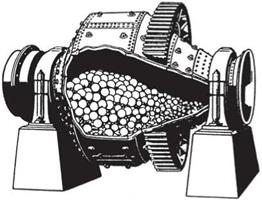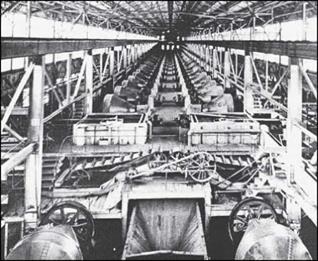For most of the 20th century, equipment manufacturers brought the main improvements to the technology of fine grinding. The Allis-Chalmers Company, for example, with its research programs and extensive publications, was a leading manufacturer of crushing and grinding machinery and one of the main contributors to better grinding technology. The Allis-Chalmers Company, then, is a good focus for a discussion of the problems confronting the mill manufacturers and how they were solved.
The company that became Allis-Chalmers was started in Milwaukee, Wisconsin, in 1847 as the Decker and Seville Company, which made millstones for grain mills from flint and chert exported to the United States from the coasts of Denmark and Normandy.
|
|
|
FIGURE 7.10 Hardinge conical mill, an early wet-grinding mill designed to improve efficiency by using segregation of the balls. The cylinder of this mill had a peripheral speed of 195 m/min, and the larger 125-mm balls remained in this section. The peripheral speeds of the conical section at the discharge end ranged from 120 to 75 m/min and the balls graded from 62 to 87 mm (Seymour 1924).
|
It was purchased by E. P. Allis & Company, which then grew because of strong management and innovative ideas. In 1901, E. P. Allis combined with other companies to form the Allis-Chalmers Company. Others in the new company were the Gates Iron Works, a large supplier of mining equipment, including tumbling mills, and the Fraser & Chalmers Company, which first made grinding mills in 1896. The merger gave Allis-Chalmers a complete line of comminution machinery that it supported by making steam engines, electrical motors, motor-starting equipment, and belt and pulley drives.
Geographically, Allis-Chalmers was well-placed to be a leading supplier of equipment for the resource industries. There were copper and iron deposits in the Upper Peninsula
of Michigan where Hardinge had his initial success, as well as in northern Wisconsin and Minnesota and in the immense wheat fields in Wisconsin and other midwestern states. With companies such as Hardinge, Marcy, KVS, Dominion Engineering, and Denver Equipment becoming involved, the early 20th century saw many competitors for the U. S. grinding mill market, and the market for tumbling mills grew quickly.
In the ore concentrators of the United States (in 1938) there are about 650 ball, rod or pebble mills operating or ready to operate and these have about 100,000 connected horsepower. For grinding in cement plants there is about three times this connected power (Coghill and DeVaney 1938).
Tube mills in 1905 were typically 1.3-1.9 m in diameter and they were powered by motors up to 22 kW. The trend in grinding mills through the 1920s, the Great Depression, and World War II was to increase mill size, and in 1951 the largest available mills listed in the Allis-Chalmers bulletin were
■ Wet-grinding rod mills: 3.2 m in diameter, 3.7 m long, 522-kW motor
■ Wet- and dry-grinding ball mills: 3.2 m in diameter, 4.9 m long, 746-kW motor
■ Dry-grinding mills with more than one compartment: 2.9 m in diameter, 10.3 m long, 932-kW motor
Although large mills may have received most of the publicity, the use of smaller mills in remote areas often required much ingenuity. Figure 7.12a shows a small mill in a mountainous area of the Philippines that was driven by a vertical water wheel and ground a few tons of ore per day. This type of small operation has always contributed to the economy of many countries. Figure 7.12b is a photo of large grinding mills in a molybdenum concentrator in the United States. These mills ground thousands of tons of ore each day and were equipped with many monitoring and control devices.
Early in the ball mill era, choosing a mill and motor for a specified feed rate, product size, and ore grindability was found to be problematic. As a result, Allis-Chalmers established a research laboratory to work on grinding, which was led by Fred Bond. Bond’s work was an important factor in making Allis-Chalmers the leader in grinding technology for much of the 20th century. His name will always be associated with ball milling.
As the diameter of tumbling mills increased, the manufacturers required advanced engineering approaches to solve design and manufacturing problems. We discuss these approaches later in this chapter.
Polysius or Krupp-Polysius mills have been mentioned several times in this history. As background, Andreas Polysius set up a mechanical workshop in Dessau, Germany, in 1859, and in 1870 he started making mills for grinding construction materials. By 1898, the company was making rotary kilns for the manufacture of cement and some years later was building complete plants. It continued to expand and in 1971 was purchased by Krupp.


